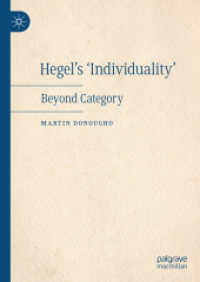- ホーム
- > 洋書
- > ドイツ書
- > Humanities, Arts & Music
- > History
- > general surveys & lexicons
Full Description
This book investigates the mixed economy of welfare that assisted socially marginalised people in interwar Europe, namely the state, local authorities, and a combination of voluntary and informal actors. While literature has traditionally emphasised the key role of the state, the cooperation between public authorities and private actors has always been a staple of social policy in Europe throughout history. The interwar years prominently featured these entanglements between the increased public sphere of action and the voluntary sector. Focusing on three thematic areas: warfare and its effects; boundaries of aid and institutional segregation; and gender and religion, the authors present case studies from various European countries between 1919 and 1939. All contributions explore the variegated world that composed the so-called mixed economy of welfare. By shifting the emphasis to the collaborations and frictions between social marginals, non-state actors, and public authorities on a local, national, and transnational level, the book challenges too simplistic distinctions between public and private initiatives and reveals the cultural, political, and practical common traits that featured in European care for marginals across a variety of geographical variations and socio-political contexts.
Contents
1. Assistance and Vulnerability in Interwar Europe: An Overview, Michele Mioni, Stefano Petrungaro.- Part I. Strains of War.- 2. New Battlefields, New Marginals: Orphans and Refugees in Zaragoza during the Spanish Civil War, 1936-1939, Ángela Cenarro Lagunas, Isabel Escobedo Muguerza.- 3. The Associative Action of the Broken Faces in the Making of a Mixed Economy of Welfare in Interwar France, Michele Mioni.- 4. Assisting the 'Legitimate Family': International Social Work for Displaced Italians, 1921-1940, Francesca Piana.- Part II. Care and Institutional Segregation.- 5. Czech Children in Need and the Mixed Economy of Welfare in Interwar Czechoslovakia, 1918-1939, Jakub Rákosník.- 6. Voluntary Aid to People with Mental Disorders in Croatia in the 1930s, Jelena Seferović .- 7. Private Actors, Public Intervention, and International Networking: Child Assistance in Interwar Lithuania, Andrea Griffante.- 8. The Marginalisation of 'Unmarried Mothers' in Ireland between 1918 and 1939, Patricia Kennedy.- Part III. Gender and Religion.- 9. Rescuing Endangered Girls: The Yugoslav Experience in a Comparative View, Stefano Petrungaro.-10. The State / Non-state Boundary, Interwar Marginality and the Lutheran Background in the Danish Welfare State, Paolo Borioni.- 11. Tramps and Girl-Mothers between Stigmatisation and Social Integration: Belgium, 1918-1940, Claudine Marissal.








